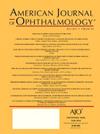IF 4.1
1区 医学
Q1 OPHTHALMOLOGY
引用次数: 0
摘要
目的:环境空气污染可能加重眼部疾病;然而,对各种污染物影响的综合研究仍然有限。评估多种空气污染物与五种常见视力威胁眼部疾病(白内障、青光眼、黄斑变性、糖尿病性视网膜病变和视网膜脱离)发病率之间的关系。设计:前瞻性队列研究方法:我们在这项前瞻性队列研究中纳入了114,930名基线时进行屈光检查的参与者,研究数据来自英国生物银行。利用土地利用回归模型评估了粒径< 2.5 μm (PM2.5)和< 10 μm (PM10)的氮氧化物(NOx)、二氧化氮(NO2)和颗粒物(PM)的年平均浓度。使用限制三次样条模型和Cox比例风险回归来估计空气污染暴露与眼病发病率之间的关系,并根据近视状况进行分层分析。结果:在近视参与者中,PM10和NOx的四分位数范围内增加与糖尿病视网膜病变的高风险显著相关,风险比(hr)分别为1.11(95%可信区间[CI]: 1.01-1.23)和1.22 (95% CI: 1.02-1.45)。PM10与近视人群中视网膜脱离发生率增加9%有关,PM2.5与非近视人群中青光眼发生率增加8%有关。在近视组中,高PM10暴露与糖尿病视网膜病变的风险增加61%相关。进一步的分层分析显示,PM10对糖尿病视网膜病变的影响在低中度近视人群中比在高度近视人群中更为明显。在低至中度近视人群中,高PM10暴露也与视网膜脱离风险增加67%和黄斑变性风险增加44%相关。结论:暴露于高水平的PM10与糖尿病视网膜病变和视网膜脱离的风险增加有关,突出了解决空气污染物作为对视力威胁眼部疾病的干预措施的重要性。本文章由计算机程序翻译,如有差异,请以英文原文为准。
Associations Between Ambient Air Pollution and Five Common Vision-Threatening Ocular Diseases in Middle-Aged and Older Adults: A Large Prospective Cohort Study
Purpose
Ambient air pollution may exacerbate ocular conditions; however, comprehensive research on the effects of various pollutants remains limited. This study aims to evaluate the association between multiple air pollutants and the incidence of five common vision-threatening ocular diseases: cataracts, glaucoma, macular degeneration, diabetic retinopathy, and retinal detachment.
Design
Prospective cohort study.
Methods
We included 114,930 participants with refractometry at baseline in this prospective cohort study based on data from the UK Biobank. Annual average concentrations of nitrogen oxides (NOx), nitrogen dioxide (NO2), and particulate matter (PM) with diameters <2.5 µm (PM2.5) and <10 µm (PM10) were assessed using land use regression models. Restricted cubic spline models and Cox proportional hazards regression were used to estimate the association between air pollution exposure and ocular disease incidence, with stratified analyses based on myopia status.
Results
An interquartile range increase in PM10 and NOx was significantly associated with a higher risk of diabetic retinopathy among participants with myopia, with hazard ratios of 1.11 (95% confidence interval: 1.01-1.23) and 1.22 (95% confidence interval: 1.02-1.45), respectively. PM10 was linked to a 9% increase in retinal detachment incidence in the myopic population, and PM2.5 was linked to an 8% increase in glaucoma incidence in the nonmyopic population. High PM10 exposure was associated with a 61% higher risk of diabetic retinopathy in the myopic group. Further stratified analysis revealed that the impact of PM10 on diabetic retinopathy was more pronounced in individuals with low-to-moderate myopia than in those with high myopia. High PM10 exposure also correlated with a 67% higher risk of retinal detachment and a 44% higher risk of macular degeneration in the low-to-moderate myopic population.
Conclusions
Exposure to high levels of PM10 was associated with an increased risk of diabetic retinopathy and retinal detachment, highlighting the importance of addressing air pollutants as an intervention for vision-threatening ocular diseases.
求助全文
通过发布文献求助,成功后即可免费获取论文全文。
去求助
来源期刊
CiteScore
9.20
自引率
7.10%
发文量
406
审稿时长
36 days
期刊介绍:
The American Journal of Ophthalmology is a peer-reviewed, scientific publication that welcomes the submission of original, previously unpublished manuscripts directed to ophthalmologists and visual science specialists describing clinical investigations, clinical observations, and clinically relevant laboratory investigations. Published monthly since 1884, the full text of the American Journal of Ophthalmology and supplementary material are also presented online at www.AJO.com and on ScienceDirect.
The American Journal of Ophthalmology publishes Full-Length Articles, Perspectives, Editorials, Correspondences, Books Reports and Announcements. Brief Reports and Case Reports are no longer published. We recommend submitting Brief Reports and Case Reports to our companion publication, the American Journal of Ophthalmology Case Reports.
Manuscripts are accepted with the understanding that they have not been and will not be published elsewhere substantially in any format, and that there are no ethical problems with the content or data collection. Authors may be requested to produce the data upon which the manuscript is based and to answer expeditiously any questions about the manuscript or its authors.

 求助内容:
求助内容: 应助结果提醒方式:
应助结果提醒方式:


